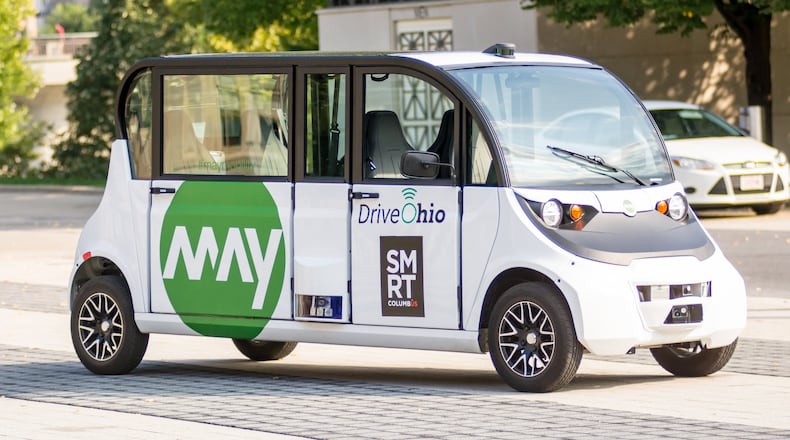“On State Route 741 we have five school buildings that are situated on that one stretch of road, and so obviously traffic in the mornings and the afternoons when school is getting in and letting out is an issue,” Springboro city manager Chris Pozzuto said.
Gov. John Kasich signed an executive order in May designed to attract more autonomous-vehicle testing to the state, looking to keep up with California and Arizona where companies are making major investments.
Springboro’s primary goal is to add artificial intelligence at four major intersections to better control traffic. Those systems are expected to learn traffic patterns and help stop lights communicate to improve the flow of traffic, Pozzuto said.
»PHOTOS: Luxury condo with downtown view on market for $320K
After traffic management, Springboro is considering adding self-driving vehicles to connect its historic district to a new 6.5-acre redevelopment that will include a performing arts center and other businesses at the corner of state routes 73 and 741 .
“It would basically look like shuttling people back and forth between those two areas to almost make them one area, so that people feel free to…use autonomous vehicles to get up and down the streets to visit the different shops in the historic district but also visit the businesses and frequent the businesses that are going in that new redevelopment,” Pozzuto said.
While Dayton’s plans are in earlier stages, city manager Shelley Dickstein said the city wants to use the technology to improve transit services.
“We are looking at autonomous vehicles as a way to make thoughtful connections in areas of our city, so that’s really what the conversation is all about — how do we use transit, autonomous vehicles in transit, to help connect people to assets, to job sites, etc,” she said.
The city benefits from wide streets and thoroughfares, where autonomous vehicles could operate in designated lanes, Dickstein said, adding that it’s very likely Dayton will see autonomous vehicles in the next few years.
“We know that autonomous vehicles are coming,” said Dayton Mayor Nan Whaley. “We want to pilot autonomous vehicles so we can learn and not be behind on this new technology … As the heart of it all, this state needs to embrace the technology coming to keep our competitive advantage, particularly on logistics and transportation.”
»PHOTOS: Here’s what local Meijer stores looked like Thanksgiving morning
Beavercreek-based Prixarc, which develops sensors that make autonomous vehicles operate more efficiently, has been interested about working with Ohio since it made the announcement about the pilot program.
Prixarc vice president Vamsy Chodavarapu and his partner, both professors at the University of Dayton, have developed sensors that can replace GPS, which isn’t reliable for self-driving vehicles in forested areas or multi-level parking garages. Now that DriveOhio is debuting its first self-driving shuttles in Columbus in December, Prixarc plans to become an active partner, Chodavarapu said.
Dayton and Springboro are the most ideal locations for testing because of their proximity to his business, Chodavarapu said.
Several other cities are also looking to DriveOhio to be on the list of early integrators of the technology, which could attract younger workers and keep Ohio cities on the map as technology transforms towns to autonomous “smart cities.”
“It clearly is a component for the younger work force as part of an effort to retain brains and talent and to continue to grow talent in the city of Dayton,” Dickstein said. “The younger workforce is certainly early adopters of these technologies.”
It would also improve last- and first-mile transit to job sites, homes and other services, she said.
»PHOTOS: Former summer cottage of John Patterson on market for $785K
“The initial stages, it doesn’t cost the city anything. DriveOhio takes care of trying to find companies that are willing to come in and use their technology both on the traffic management side and the autonomous vehicles,” Pozzuto said. “Right now we don’t have any money appropriated for this and don’t anticipate any in the near future, so that’s what made the program look very attractive to us.”
But the biggest benefit of self-driving vehicles is safety, said ODOT spokesman Matt Bruning.
“You think about the fact that 94 percent of all crashes begin with human error. If you can reduce that percentage drastically, you can reduce the number of serious and fatal crashes. That’s what we really hope that does and we think this can really be a game changer for safety,” he said.
Though some area leaders voiced concern about the safety of autonomous vehicles when DriveOhio visited Dayton last month, Bruning said the test shuttles will have an operator who can intervene if needed.
Ohio is a prime location for testing because it experiences all four seasons, has varying geography from urban to farmland and is within 600 miles of about 60 percent of the United States and Canadian population, Bruning said.
FIVE FAST READS
• How to protect yourself from cyber thieves this shopping season
• 5 ways new tech will change your holiday shopping experience this year
• Store hours: Here’s when retailers will open for Thanksgiving, Black Friday sales
About the Author
